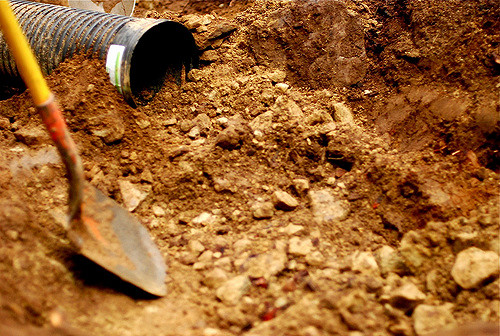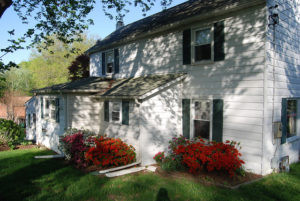Drainage: Improve Your Property Grade

It’s easy to forget that homeowners shouldn’t just look at the basement and foundation to explain water damage. Of course, if anything is leaking, that’s a sure sign that something is wrong with them, but the amount of water and damage can depend on not just the foundation, but the drainage of the land that surrounds it, too.
Homeowners should know the gradient around their home and whether or not there have been problems with leaks and moisture associated with it. If your home sits on flat land or, worse, if the land slopes toward your foundation, any problems that might arise in the future will be made much worse; and if you’re already having problems, they could be solely the problem of drainage.
What can you do to ensure you won’t get an “F” in land grading? For starters, you need to check your sloping.
Sloping and Drainage
The slope and grading away from your foundation is important because it drains the water away; poor sloping means you’ll have water pooling around the foundation, and it doesn’t take much for it to leach into your basement. It doesn’t matter what kind of ground your foundation sits in – sloping is the most important determinate to seepage and drainage.

This side needs better drainage.
A good slope to have away from your home is six inches for the first twenty feet; you can measure it yourself! Take two stakes, put one right at the foundation and one ten feet away, and string the two of them together. Measure the height of the string on the further stake from the ground (make sure that the string is perfectly level across; the string on the foundation stake should be at ground level). If it’s two to three inches or more off the ground, you probably have an adequate slope and drainage shouldn’t be a problem. If it’s less, or there’s no gradient at all – you need sloping.
Make sure to calculate all around your home. The front and back gradients can be very different, and usually the front yard is flatter than the back.
What Can You Do?
It all depends on how big a gradient you need. If it’s only a small gradient, renting equipment like a landscaping rake, getting some soil, and removing the topsoil can be done by yourself. Then adjust the subsoil by clearing away higher ground and smoothing out lower ground. Take two inches of topsoil and till it into the first two inches of subsoil. This will help prevent drainage problems between the two layers of soil. Then spread the rest of your topsoil, which should add at least another four inches. The final gradient should work with some more permanent fixtures of your landscape, such as walkways and driveways.
Sometimes, though, it’s best to leave it to the professionals, especially when you’re already battling a leaky basement. Fixing a gradient can, in some circumstances, be an intensive work project, especially if you’re on very uneven land or you’re not so good at landscaping. A professional crew can ensure everything is even and looks great, and work with the rest of your property to ensure drainage goes where you (or your neighbours) would prefer.
So if you’re not sure about the process, give us a call. Proper drainage and dry basements are what we live for!
